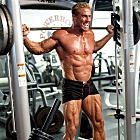 Q: I have good form on the squat, but I often strain my lower back on it. As a result I stick primarily with leg presses and machine hack squats, but would Smith-machine squats be better? I really want to do some heavy-duty compound movements to help me lose belly fat.
Q: I have good form on the squat, but I often strain my lower back on it. As a result I stick primarily with leg presses and machine hack squats, but would Smith-machine squats be better? I really want to do some heavy-duty compound movements to help me lose belly fat.
A: Before blaming squats for your back pain, consider that it may be related to your being overweight.
Being overweight or obese causes changes in posture that may affect normal biomechanics and cause back pain. Look at what frequently happens to women during the later stages of pregnancy; when they are at their heaviest, many women experience lower-back pain. After childbirth the pregnancy-related back pain typically resolves, provided the women did not have back pain before getting pregnant.
So losing weight may be an effective way to resolve many back-pain problems. As such, simply losing weight through a combination of exercise and diet may significantly reduce your risk of injuring yourself on squats.
Next, it’s a misconception that the machines you mention place zero stress on the lower back. In fact, due to structural imbalances you may have in your body, those machines could make you more susceptible to lower-back pain. Although machines don’t require you to hold a barbell on your shoulders, as you would with a squat, any form of force, whether it’s through shoulder pads or a footplate, creates compressive loading on the spine. So, if you continually increase the strength of your legs on these machines, you’re increasing the compressive forces on your spine.
Further, when using leg press machines, there is a tendency to lower the footplate too far, causing the lower back to round. You wouldn’t perform heavy deadlifts with a rounded back, so it follows that you shouldn’t round your back on leg presses.
With Smith machines you’re limited to a fixed, unnatural movement pattern. Everyone has some degree of asymmetry, and a barbell (unlike a mechanical apparatus) will shift to accommodate it. In fact, if you look at slow-speed videos of top Olympic lifters, you’ll see that they often land with one foot in front of the other and slightly twist when coming up out of the squat. Those movement patterns are not consciously practiced; they are simply the body’s way of finding the most efficient method of lifting.
The bottom line here is that if you have a problem with straining your back on squats, training just on machines may not be the solution. I suggest that you see an appropriate health-care provider to determine what is causing the problem, and from there work with qualified therapists and trainers to resolve it so you can get back to squatting.
One reason many trainees don’t do squats is that they believe it’s the weak link in developing their legs, which can be true. By focusing on the machines, you create a greater muscle imbalance, potentially making you more susceptible to straining your back.
Editor’s note: Charles Poliquin is recognized as one of the world’s most suc-cessful strength coaches, having coached Olympic med-alists in 12 different sports, including the U.S. women’s track-and-field team for the 2000 Olympics. He’s spent years researching European journals (he’s fluent in English, French and German) and speaking with other coaches and scientists in his quest to optimize training methods. For more on his books, seminars and methods, visit www.CharlesPoliquin.com. Also, see his ad on the opposite page. IM




















You must be logged in to post a comment Login